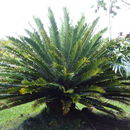Biology
provided by Arkive
Cycads are long-lived, slow-growing plants that bear their reproductive organs in cones on separate plants, with male cycads bearing cones that contain pollen, and female cycads producing cones that contain ovules that later become seeds (4) (5) (6). There is no way of determining the sex of a cycad until it begins to produce its first cone (6). For a long time cycads were thought, like cone-producing conifers, to be entirely wind pollinated (7). However, studies now suggest that the vast majority, if not all cycads, are actually pollinated by insects or more specifically weevils (5) (6) (7). To attract pollinators, male and female cones produce powerful odours, usually in the early morning or evening (6). Travelling between the sexes, the weevils pollinate the plants by inadvertently transferring pollen from the male cones to the receptive ovules of the female cones (6) (8).
The seeds produced by cycads are large and have a fleshy outer coat, but are relatively short-lived and vulnerable to desiccation (5). The fleshy red seeds of the Eastern Cape giant cycad are known to attract the Knysna turaco and trumpeter hornbill (9). Consuming the seeds, the birds digest the outer coat but subsequently regurgitate the unpalatable seed. If the seeds are discarded in a hospitable environment, there is a relatively good chance they will germinate and grow into a mature plant (5) (9).
Conservation
provided by Arkive
There are no specific conservation measures in place for the Eastern Cape giant cycad, but it is listed on Appendix I of CITES, which permits trade only under exceptional circumstances (3).
Description
provided by Arkive
In a conservatory at Kew Royal Botanic Gardens lives one of world's oldest pot plants, an Eastern Cape giant cycad collected in South Africa in the early 1770s (4). This popular ornamental species has a tall, stout stem, topped with a dense, upright crown of bright-green palm-like leaves up to 2.5 metres in length (2). Although woody in appearance, the stem is mostly comprised of soft, pithy storage tissue protected by a solid layer of old leaf bases (5) (6). Initially, the single stem is erect, but over time it usually begins to recline at an angle, and may sucker from the base to form a clump of multiple stems (2) (5). The sexes are borne on separate plants, as indicated at reproductive maturity by the presence of two to five male or female cones on each stem (5) (6). The large, yellowish green female cones are egg-shaped, almost resembling a pineapple, while the similarly coloured, but smaller, male cones are cylindrical (2) (5).
Habitat
provided by Arkive
Found near the coast in habitat ranging from open shrubland on steep rocky slopes to closed evergreen forest in valleys (1).
Range
provided by Arkive
The Eastern Cape giant cycad is widely distributed in the Eastern Cape and south-western KwaZulu-Natal, South Africa (1).
Status
provided by Arkive
Classified as Vulnerable (VU) on the IUCN Red List (1) and listed on Appendix I of CITES (3).
Threats
provided by Arkive
Although land clearance has claimed hundreds of Eastern Cape giant cycads, and numerous plants have been taken from the wild to sustain nurseries, this species remains common throughout its range (6).
Encephalartos altensteinii
provided by wikipedia EN
Encephalartos altensteinii is a palm-like cycad in the family Zamiaceae. It is endemic to South Africa. The species name altensteinii commemorates Altenstein, a 19th-century German chancellor and patron of science.[3] It is commonly known as the breadtree, broodboom, Eastern Cape giant cycad or uJobane (Zulu).[4] It is listed as vulnerable due to habitat destruction, use for traditional medicine and removal by collectors.[1]
Description
Male cones (above) and female cones (below)
This cycad grows up to seven metres tall and may be branched or unbranched. The leaves are straight or curved backwards and up to three metres in length. The leaflets are rigid and fairly broad with one or both margins toothed. There are no prickles at the base of the leaf which distinguishes it from E. natalensis. There are usually two to five greenish-yellow cones up to fifty centimetres long, the female scales covered with protuberances. The cones are poisonous to humans.[5] The seeds are scarlet and up to four centimetres long.[4]
Distribution and habitat
This species is widespread in the Eastern Cape and south-western KwaZulu-Natal provinces of South Africa. It favours sites near the coast including open scrub, steep rocky slopes, evergreen forests in valleys[6] and river banks. It also occurs inland at a higher altitude in isolated sites in the Amatola Mountains.[1]
References

- license
- cc-by-sa-3.0
- copyright
- Wikipedia authors and editors
Encephalartos altensteinii: Brief Summary
provided by wikipedia EN
Encephalartos altensteinii is a palm-like cycad in the family Zamiaceae. It is endemic to South Africa. The species name altensteinii commemorates Altenstein, a 19th-century German chancellor and patron of science. It is commonly known as the breadtree, broodboom, Eastern Cape giant cycad or uJobane (Zulu). It is listed as vulnerable due to habitat destruction, use for traditional medicine and removal by collectors.
- license
- cc-by-sa-3.0
- copyright
- Wikipedia authors and editors

